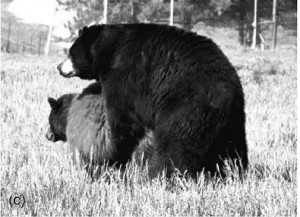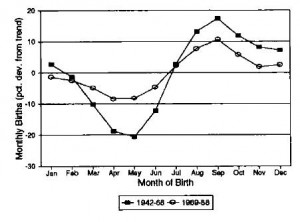I’ve adapted much of this chart from Howell-Skalla (2002) and Tsubota (1998).
Canadian polar bears: bona fide seasonal breeders.
The light cycle increases until June, then decreases until December. Melatonin goes in the exact opposite direction. Testosterone peaks around the onset of breeding season (springtime, April/May), coinciding with LH (as expected). There is also a lot of bear-on-bear violence at this time due to: 1) testosterone-induced aggression; and 2) the high female:male ratio –-> females rear their cubs and are thus out of the game for about 3 years, but males like to breed every year.
Females followed a similar pattern, with estrogen peaking around breeding season and prolactin following the light cycle.
The authors mentioned that prolactin levels mirrored day length, and according to Wiley this would be the prolactin peak that normally occurs when you’re sleeping, but has spilled over into the daytime due to short sleep / long light cycle… not total prolactin levels (24h AUC?), which should be highest in winter (see below).
Female bears get pregnant in spring, corresponding with peak estradiol, but apparently the fertilized egg doesn’t implant for a few months, when they enter their dens in the autumn; this corresponds with a peak in progesterone.
The prolactin picture is admittedly the most difficult for me to grasp (circadian AND circannual rhythms
), but is at least starting to come together: they also mentioned that, in black bears, preventing the spring seasonal increase in daytime prolactin with a long acting form of bromocriptine resulted in lower serum testosterone and prevented both an upregulation of testicle LH receptors and maximal testicular growth.

Hamsters operate on a similar level: breeding during the waxing light cycle & not so much in winter. Klosen (2013) showed some of this is mediated by TSH. In short-day adapted hamsters (winter; high melatonin), infusion of TSH switched the gonadotropic axis from winter to summer-breeding mode = increased fertility. Long light cycle induces TSH, which stimulates sex hormones.
The authors showed that melatonin inhibits TSH, which reduces these “RF-peptides” and thus impairs fertility. Lowering melatonin levels in spring = high “RF-peptides” = increased fertility. “RF-peptides” activate testicular activity [in hamsters]. While TSH & T3 might seem useful to keep us warm in the winter, their local effects are actually rather important in these seasonal breeders to promote sex hormones and fertility.
New conclusion – -> endogenous melatonin proper: good for sleep & health, but low levels in summer still better for fertility. Prolactin might be more similar to dopamine in at least one regard: for dopamine, it’s all about “location, location, location!” Ie, in which region of the brain is dopamine acting. For prolactin, it seems to be all about “timing!”
If we assume the black bars indicate night time in the figure above, and that in spring they should be getting smaller (but aren’t), then I can see how there might be some prolactin spillover into the daylight hours (Haus 2007). Overall levels still way higher in winter, though.
What about humans? According Lam & Miron (1994), conception actually follows an opposite pattern. The figure below is from Louisiana, but similar trends were found for a variety of locations.
I don’t think this means the model is wrong, but rather that we are. Bollixed, that is. This is purely speculative, but the seasonal impact on birth rates has steadily declined over time, which may partially reflect the increased use of artificial lights and all of our attempts to subvert circadia. Note how the height of the troughs & peaks varies widely 50-60 years ago, indicating strong seasonal effects, but by 1990 is reduced by over half:
This was indirectly confirmed by Cummings (2007) who showed that in Germany, the peak in birth rates gradually shifted from spring in 1950 to autumn in 1990. And a complete loss in seasonality occurred in Spain between 1940 & 2000 (Cancho-Candela et al., 2007).
Courtesy of Boone (2003):

If you’re interested in personalized health consulting services, send me an email: drlagakos@gmail.com.
Affiliate links: The Keto Box and KetoAF Homepage for keto-friendly shakes and snacks, etc. And get 15% off your ketone measuring supplies HERE.
Still looking for a pair of hot blue blockers? TrueDark is offering 10% off HERE and Spectra479 is offering 15% off HERE. If you have no idea what I’m talking about, read this then this.
Join Binance and get some cryptoassets or download Honeyminer and get some Bitcoins for free! Delish stocks and broths from Kettle & Fire.
If you want the benefits of ‘shrooms but don’t like eating them, Real Mushrooms makes great extracts. 10% off with coupon code LAGAKOS. I recommend Lion’s Mane for the brain and Reishi for everything else.
Join Earn.com with this link.


